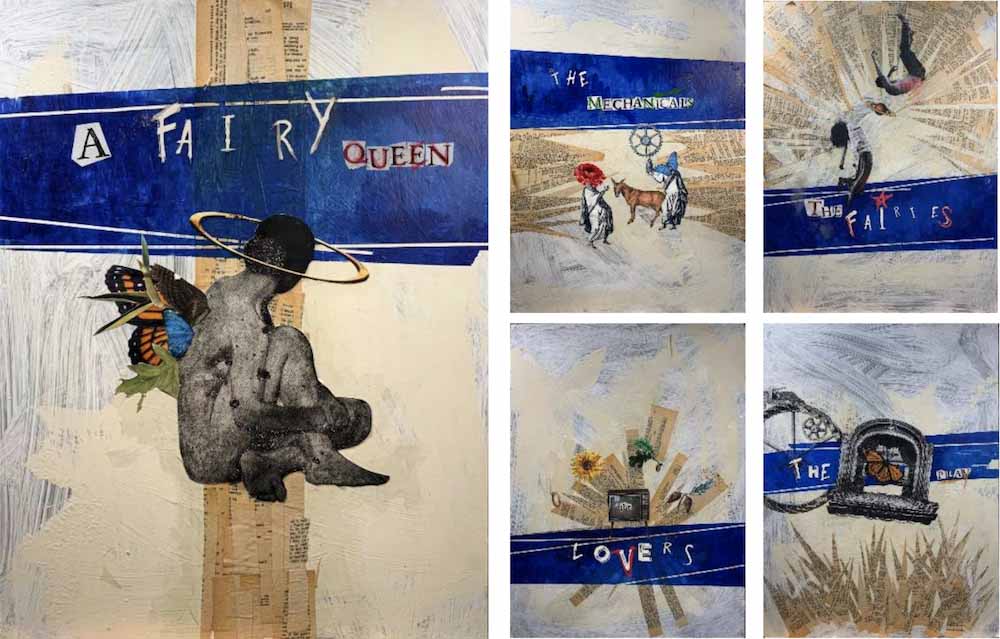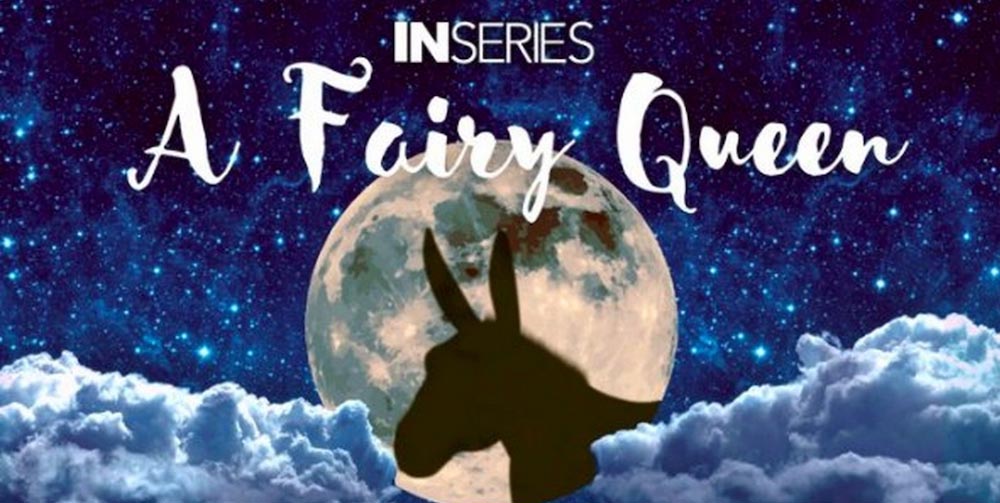“All shall be well, and all manner of thing shall be well.” — Julian of Norwich included in A Fairy Queen
“The same elements that make magic possible, also make it dangerous.” — A Fairy Queen
On the one hand, for some, this pandemic in combination with the world’s seemingly inescapable drift towards fascism, oligarchy, and climate collapse has given rise to despair. On the other hand, as IN Series Artistic Director Timothy Nelson points out in his address to the audience, “at this liminal moment of insight, here we are, watching a new dawn, and looking up to see greater possibility where before we had perceived none.”
And so, the production of A Fairy Queen that had been planned as a live performance for the fall of 2020, in the face of pandemic shutdowns, was reimagined as the world’s first podcast opera. For the current production, it has been reworked once again to evoke the experience of attending a live recording session of an old-time radio program, complete with live sound effects.
I invited my friend, performer, and visual artist Wayson Jones to see this performance with me. I’m glad I did. He is someone who is used to engaging with the unexpected. And the unexpected has become the IN Series stock in trade. While I often respond to IN Series’ work with a kind of unshaped enthusiasm, Wayson channels what he sees into the reshaping of his own art. We had seen dancer-choreographer Akram Kahn perform his “end-of-the-world” piece, Xenos, a couple of weeks prior, and I thought Wayson might enjoy IN Series’ way of doing things. Wayson performed regularly with now-deceased Black gay poet icon Essex Hemphill, shaping poems into performance art that would be underscored by his keyboard work. He now focuses on his visual art. When I asked him what I should be sure to mention in this review, he mentioned four things: the radio program format, the entire company as an Ensemble, the counter-tenor Benjamin Williamson, and soprano Claron McFadden.

Firstly, centered on music by Henry Purcell and Shakespeare’s A Midsummer Night’s Dream, this show is A Fairy Queen, not The Fairy Queen. The title change reflects the fact that in the 17th century when this work was originally produced, it was common practice to co-opt older popular plays and cobble them together with music to make a new and marketable product. In today’s parlance would we call this “sampling”? At any rate, that’s how this production was assembled, too. Watching what was happening onstage, especially in the opening moments, Wayson called it a “mashup,” a term and practice 21st-century artists readily recognize.
The Live Radio Program Format. Placing this story in a radio studio goes right along with 17th-century versions of the practices of sampling, remixing, and mashup. And in Nelson’s knowledgeable hands it comes off not like a gimmick but as a doorway into discovery of connections between human emotion and experience in the two different eras. Who knew that lust and naughtiness in 17th-century Europe were not merely academic? Hearing Alleluias sung by Lucy Page with unmistakable orgasmic intent made me wonder “How long has this been going on?” and how much have I been missing when I encounter these older works?
The show begins with the participants waiting for their cues to start. While waiting, they stand around in various affinity groups chatting, like office workers around a water cooler. (We see instrumentalists, singer-actors, sound techs making last-minute adjustments with relevant performers.) We see a company of professional performers, some barefoot, some in stocking feet, in pre-performance mode. They are called to assemble by the voluble, playfully sexy, and molasses-voiced narrator (John T. K. Scherch), whose tendency to say more than is necessary is contained by the insistent “Hush!” uttered by the first official character to speak, the actor/spirit Puck (Enrico Lagasca). It’s an utterance that calms the actors as well as the audience and brings us all into a sacred space. And it ultimately becomes a central theme of this production. After Puck speaks, introductions to the audience and an explanation of how things will proceed begin. But instead of being given straightforwardly, the words of the speakers overlap and interweave in a kind of verbal fugue.
There is an “On Air” sign that lights up, alerting the audience and performers to pre-performance silence. The live sound effects are in full view. “Applause” and “Silence” cards for the audience are held up to guide audience reaction at critical moments. The performers are seated in folding chairs and come forward to microphones when it’s their turn to speak or sing. The orchestra is also in full view of the audience. Every part of the space has some kind of performance happening in it. There is a lot to look at like in a circus. Like a circus, this is fun for both the audience and the performers who clearly enjoyed themselves. And even though you can see so much there are still surprises.
Everyone in this show is a magnificent singer and laudable actor. It is a gift to experience them in performance. There were some moments in this show that I was not expecting.

Countertenor Benjamin Williamson. Maybe it’s just not possible for a countertenor not to stand out in some way. However, as Oberon, Benjamin Williamson stands out in the best way possible. His Oberon is focused, attentive, and responsive, displaying deeply committed, high-stakes emotion that is always on the verge of something significant in combination with a seemingly contradictory combination of virility, sensitivity, and arrogance. If that’s not Oberon, I don’t know what is. Throughout the story, Williamson’s voice is undeniably present and supportive yet not intrusive. But it was his rendition of “Music for a while” that blew the audience away. It was a truly collaborative performance in which this 17th-century European music was either revealed to be nascent 20th century American jazz or was transformed into something that sounded a lot like jazz. The cellist (Wheeler Jarvis) turned Purcell’s musical ground into a solid walking bassline in tandem with piano playing (Emily Baltzer) that put me in mind of John Lewis and the Modern Jazz Quartet. I tapped my feet, swayed, and nodded my head to it.
Soprano Claron McFadden. One of the surprises in this circus of a production is the entrance of soprano Claron McFadden. At one point someone from the stage calls out to the audience for assistance with a part. We hear a voice in the auditorium’s darkness cry out, “Do you mean me?” “Yes!” McFadden gleefully lifts her voice in a series of flawless baroque trills and runs executed with playfulness and apparent effortlessness. Hers is a supple, flexible instrument that was the highlight of an evening with an abundance of wonderful singing. It’s worth noting that McFadden will be singing the music of Nina Simone in the production of Toni Morrison’s Desdemona that IN Series is producing later this season. It’s an experience that I will not be missing.
The Ensemble. This production offered several opportunities for duets, trios, quartets, and for the entire ensemble to sing together. When in these small group configurations the performers were not soloists who just happened to be singing at the same time. The voices were technically “balanced.” But more than that the singers were in conversation with each other and responded to each other in whatever permutation they were in. The voices were sensually interactive. We didn’t just listen to the music projected into the hall. We also were able to experience the music passing back and forth between the singers, with tenderness and respect for each other and the material.
And that final number! The show closes with Hush, No More during which the audience seemed to hold its collective breath. Maybe this moment was about more than the end of the show. The narrator proposes that they should end with an epilogue but the entire cast objects. And Puck once again advises our narrator to “Hush!” It felt like this song was recognizing the audience’s present anxieties and calling us, encouraging us, to use our inner resources to calm the voices of panic and despair in our heads (“Be silent all! No noise! No noise!) and to return (“Softly, softly steal from hence!”) to our sexuality, our sensuality, our colleagues, our families, our beauty, laughter, and joy. And our hope.
Running Time: Approximately 2 hours 30 minutes with a 15-minute intermission.
A Fairy Queen played December 4 and 5, 2021, presented by IN Series performing at Atlas Performing Arts Center, 1333 H St NE, Washington, DC.
A FAIRY QUEEN
After Shakespeare’s A Midsummer Night’s Dream
Music by Henry Purcell
Conceived and conducted by Timothy Nelson
Peter Quince/Fairy: Sara Couden
Bottom/Demetrius: Marc Callahan
Puck/Robin Starveling: Enrico Lagasca
Snug/Helena: Sylvia Leith
Titania: Lucy Page
Snout/Lysander: Aaron Sheehan
Oberon: Benjamin Williamson
Flute/Hermia: Melissa Wimbish
Trumpet: Claron McFadden
Fairy Ensemble: Rachel Evangeline Barham, Andrew Sauvageau, James Rogers
Piano: Emily Baltzer
Cello: Wheeler Jarvis
Harpsichord/organ: Timothy Nelson
Violin: Jeffrey Thurston
Cello: Maxfield Wollam-Fishe:
Head of Music: Emily Baltzer
Lighting Designer: Paul Callahan
Sound Effects Artist: Jill Ahrold Bailey
Stage Manager: Joe Gladstone
Associate Artistic Producer: Corinne Hayes
SEE ALSO:
IN Series sets season of live theater centering DEI (season announcement)





